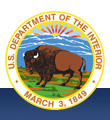For Immediate Release: September 24, 2009
Contact: Rick Westerhof; (231) 584-3553; Rick_Westerhof@fws.gov
Ashley Spratt; (612) 713-5314; Ashley_Spratt@fws.gov
FFS #R3TE
BARRY CO., MI - Secretary of the Interior Ken Salazar announced a $74,900 grant was awarded to the Barry Conservation District for the removal of Nashville and Maple Hill Dams on the Thornapple River in Barry County, Mich. The project will be funded by the American Recovery and Reinvestment Act.
“The economic recovery investments that the Department of the Interior is making will create jobs by building trails, restoring habitat, upgrading visitors’ centers, and protecting national treasures in communities across America, while leaving a lasting legacy for our children and grandchildren,” said Secretary Salazar.
Removal of the Nashville and Maple Hill Dams will open up 60 mainstem and 105 tributary stream miles and reconnect five inland lakes to the Thornapple River, which will benefit fish and other aquatic resources. Habitat fragmentation has caused loss of species diversity upstream of the dams.
“The Midwest Region has a long tradition of enjoying the fish, wildlife, lakes, rivers and prairies we are so fortunate to have,” said U.S. Fish and Wildlife Service Midwest Regional Director Tom Melius. “The projects we will undertake in the Midwest as part of ARRA will provide jobs, increase the energy efficiency of government buildings, protect and enhance our natural resources, provide greater opportunities for people to enjoy those natural resources, and perhaps most importantly, help current and future generations understand and share our passion for the natural world.”
Future grant awards will be announced when known. Grant opportunities for all ARRA projects are announced on the Internet at http://www.grants.gov. More information about this and other U.S. Fish and Wildlife Service projects is available at http://recovery.doi.gov/press/bureaus/us-fish-and-wildlife-service.
Funding for these projects and hundreds more across the nation comes from the American Recovery and Reinvestment Act of 2009. Of the $3 billion appropriated to the Department of the Interior, the Act provides $280 million for the U.S. Fish and Wildlife Service – which includes $115 million for construction, repair and energy efficiency retrofit projects at Service facilities, and $165 million for habitat restoration, deferred maintenance and capital improvement projects. The Service will benefit from an additional $10 million, which is administered by the Department of Transportation and is not included in the Service’s $280 million appropriation that will be used to rebuild and improve roads on several national wildlife refuges. Projects will immediately create local jobs in the communities where they are located, while stimulating long-term employment and economic opportunities for the American public.
Recovery Act projects address long-standing priority needs identified by the U.S. Fish and Wildlife Service through its capital planning process. The Service worked through a rigorous merit-based process to identify and prioritize investments meeting the criteria put forth in the Recovery Act: namely, that a project addresses the Department’s highest priority mission needs; generates the largest number of jobs in the shortest period of time; and creates lasting value for the American public.
Under the American Recovery and Reinvestment Act, the Department of the Interior is making an investment in conserving America’s timeless treasures – our stunning natural landscapes, our monuments to liberty, the icons of our culture and heritage – while helping middle class families and their communities prosper again. Interior is also focusing on renewable energy projects, employing youth and promoting community service.
For a full list of funded projects nationwide, go to the Department’s Recovery Web Site at http://recovery.doi.gov/. For a list of Service projects, click on the Service’s logo at the bottom of the page. Secretary Salazar has pledged unprecedented levels of transparency and accountability in the implementation of the Department of the Interior’s economic recovery projects. The public will be able to follow the progress of each project on the recovery web site, which will include an interactive map that enables the public to track where and how the Department’s recovery dollars are being spent. In addition, the public can submit questions, comments or concerns at recoveryact@fws.gov.
Secretary Salazar also has appointed a Senior Advisor for Economic Recovery, Chris Henderson, and an Interior Economic Recovery Task Force. Henderson and the Task Force will work closely with the Department of the Interior’s Inspector General to ensure the Recovery Program is meeting the high standards for accountability, responsibility and transparency that President Obama has set.
The mission of the U.S. Fish and Wildlife Service is working with others to conserve, protect and enhance fish, wildlife, plants and their habitats for the continuing benefit of the American people. We are both a leader and trusted partner in fish and wildlife conservation, known for our scientific excellence, stewardship of lands and natural resources, dedicated professionals and commitment to public service. For more information on our work and the people who make it happen, visit www.fws.gov.







